NCERT Class 11 Biology Chapter 16 Notes Digestion And Absorption- Download PDF Notes
Digestion and Absorption is a very important chapter of the NCERT Human Physiology: Digestion and Absorption from an Exam Point of View. The NCERT Class 11 Biology Chapter 16 notes give you a basic idea of the chapter on digestion and absorption. Class 11 Biology chapter 16 Digestion and Absorption NCERT Notes will teach you about the human digestive system, the mechanisms of digestion of food, absorption of these digested products, and several disorders of Digestive System.These notes will provide you with additional information on the topic, which will aid you in passing your tests and examinations. Students can also choose to download the XI class Digestion and Absorption notes pdf file. Download the CBSE Notes for Class 11 Biology, Chapter 16, PDF to use offline anywhere. Students must go through each topic in the digestion and absorption Class 11 Notes Biology in the easiest and most effective way possible with the help of NCERT Notes for Class 11.
This Story also Contains
- NCERT Class 11 Biology Chapter 16 Class Notes
- Digestion and Absorption
- Digestive System
- Digestive Glands:
- Digestion of Food
- Absorption of Digested Products
- Disorders of Digestive System
Class 11 Biology chapter 16 notes also cover all the important concepts related to mechanism of the digestive system and associated digestive glands, which are useful in various competitive exams. Digestion and absorption NCERT Notes for Class 11 Biology help you revise these major concepts given in the NCERT Book in a short period of time during CBSE Board exam preparation. CBSE Class 11 Biology Chapter 16 notes will help you with quick revision. The Digestion and Absorption chapter covers all headings of NCERT. CBSE Class 11 Biology chapter 16 notes also contain important examples that have been frequently asked in the various exams. Having revision notes and NCERT Solutions for Class 11 Biology Chapter 16 handy saves you time. The NCERT Class 11 notes pdf can be downloaded through the link given below.
Also, students can refer,
NCERT Class 11 Biology Chapter 16 Class Notes
Digestion and Absorption
- Although carbohydrates, proteins, and fats are the major components of food, vitamins and minerals are also required by our body in small quantities.
- Food provides energy and organic materials for the growth and repair of body tissues. Water helps in the metabolic processes of the body and prevents dehydration.
- Our food consists of macromolecules that can’t be used by our body in their original form.
- The mechanism of converting complex food substances into simple absorbable forms is called digestion.
- Digestion is administered by our gastrointestinal system by mechanical and biochemical methods.
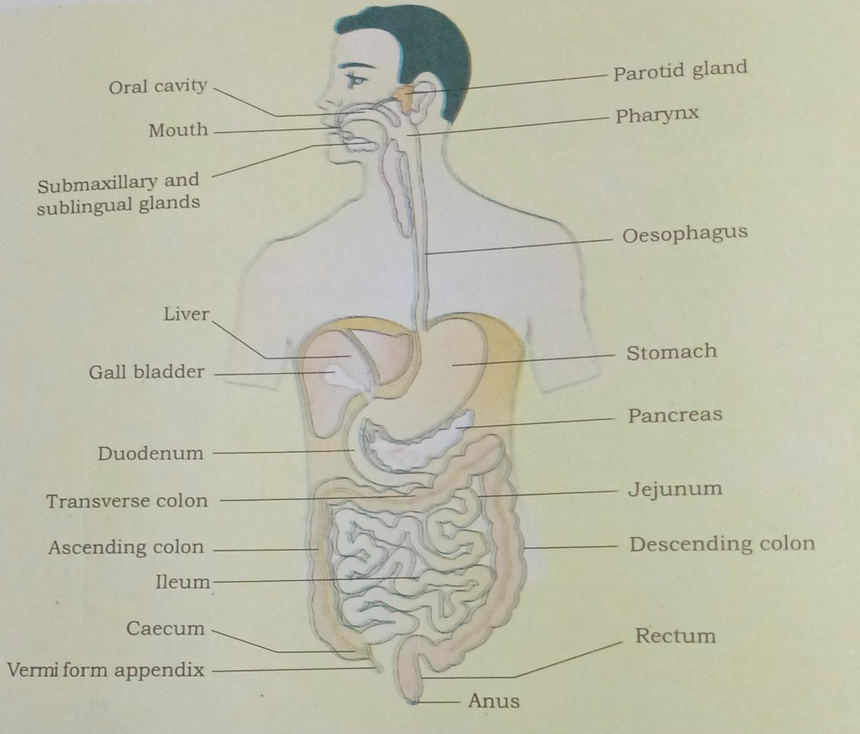
The Human Digestive System
Digestive System
The digestive system of humans consists of the alimentary canal and the associated glands.
Alimentary Canal:
- It is a long and muscular tube that runs from mouth to anus. The accessory glands of the digestive system like salivary glands, liver, and pancreas pour their secretions into the canal through their ducts.
- The alimentary canal has the following distinct regions:
1. Buccal (oral) cavity
2. Pharynx
3. Oesophagus (food pipe)
4. Stomach
5. Small intestine
6. Large intestine
1. Buccal Cavity:
- It performs the function of ingestion, mastication, and solving of food. It consists of teeth, tongue, and its muscles. Teeth are embedded in jaws. This type of attachment is called thecodont.
- In human beings, teeth are naturally replaced once in life. So, they have two successive sets of teeth. Such a condition is called diphyodont. Deciduous teeth refer to the first set of teeth that appear in the body. They are also called milk teeth. They do fall off and are then replaced by permanent teeth.
- An adult human being has four types of teeth and they differ in shape and function. Man has 32 permanent teeth set in 2 jaws, namely incisors (I), canines (C), premolars (PM) and molars (M)
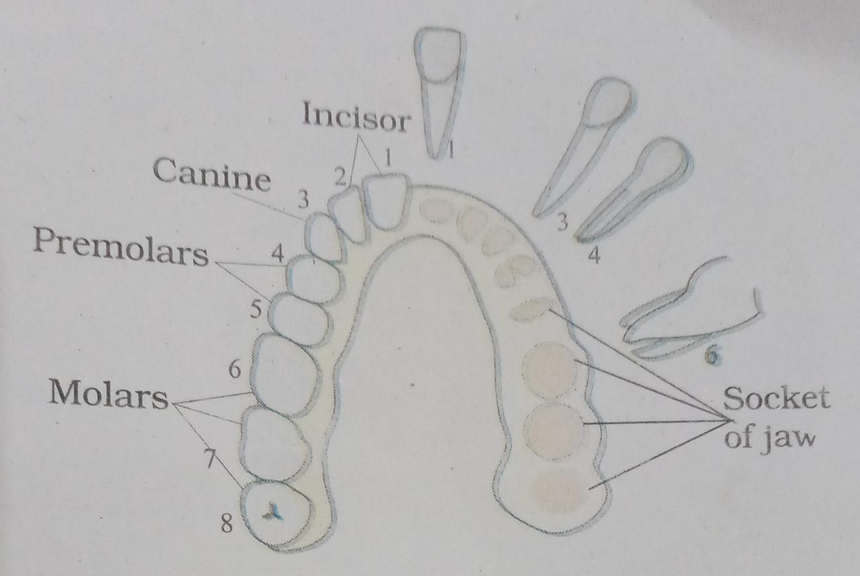
Arrangement of different types of teeth in the jaws, on one side
- The arrangement of teeth in each half of the upper and lower jaw is represented by a dental formula. The dental formula in humans is 21232123. It is in the order- I, C, PM, M. The hard chewing surface of the teeth is made up of a substance called enamel. It helps in the mastication of food.
2. Pharynx:
The pharynx acts as a common passage for food and air.
3. Oesophagus:
It is a thin, long tube that leads to the stomach. Gastro-oesophageal sphincter regulates the opening of oesophagus into the stomach.
4. Stomach:
- The stomach is situated in the upper-left portion of the abdominal cavity.
- It is J-shaped and has three parts- fundus-upper part, cardiac - middle part, and pyloric- lower part.
- The fundus is towards the oesophagus, cardia is the middle part and food passes into the duodenum through the pylorus.
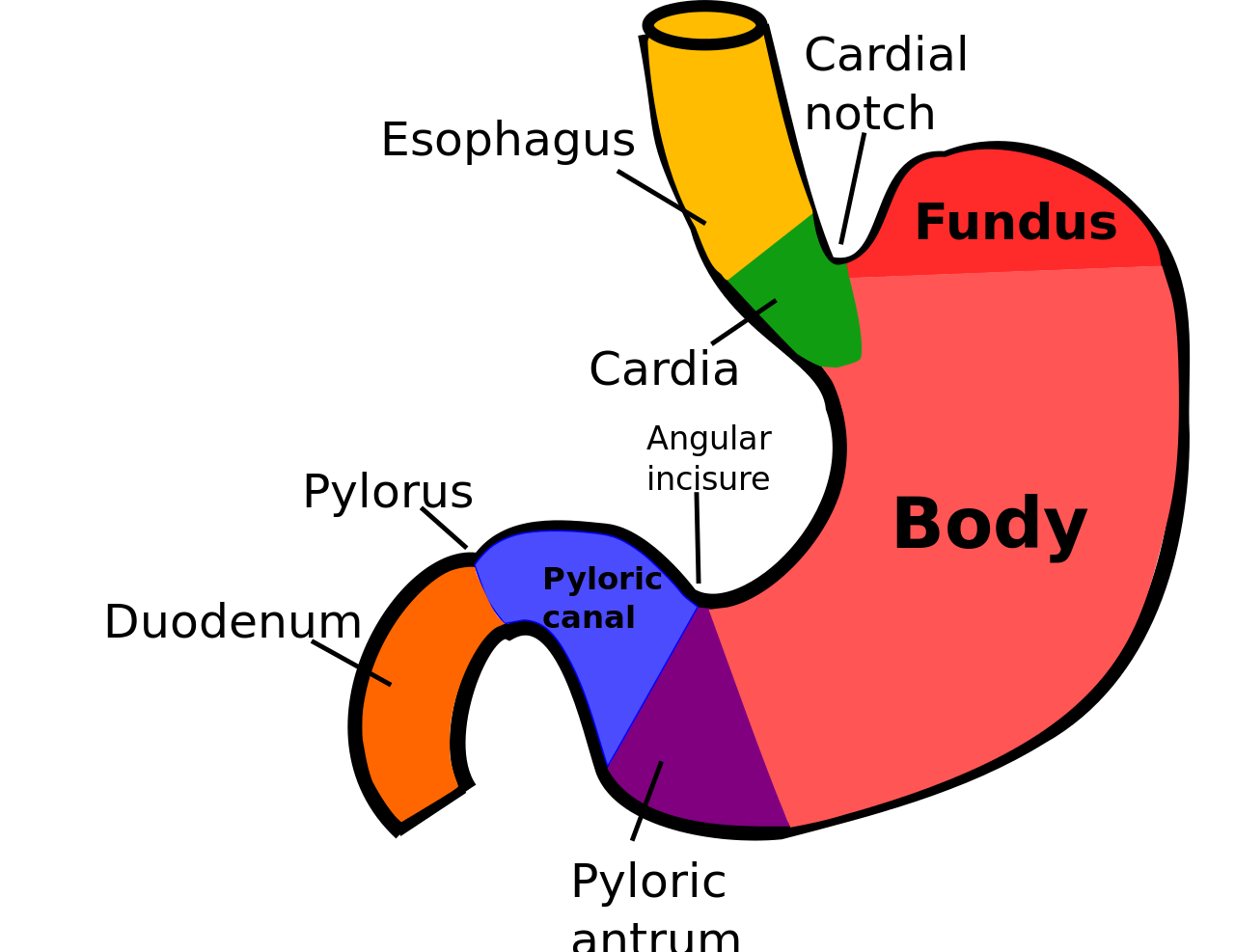
Anatomical regions of human stomach
- Pyloric sphincter is present between the pyloric region of the stomach and duodenum. It is a ring of smooth muscles. It stops and closes several times.
5. Small Intestine
It consists of three parts known as duodenum, jejunum, and ileum.
a. Duodenum: It forms the upper part of the small intestine which is ‘C’-shaped.
b. Jejunum: Duodenum leads to a coiled tube called the jejunum.
c. Ileum: It is a highly coiled region of the intestine.
6. Large Intestine:
- It absorbs the water and discharges the undigested waste.
- It has three parts- caecum, colon, and rectum.
- The caecum is a blind sac and some symbiotic microorganisms reside in it. In the case of humans, it is very small and from it extends a small finger-like vermiform appendix which gets infected during appendicitis, it is a vestigial organ.
- The caecum opens into the colon and is divided into 3 parts – an ascending, a transverse, and a descending part.
- The rectum is a small muscular region at the end of the large intestine that can store the undigested food before passing it out through the anus.
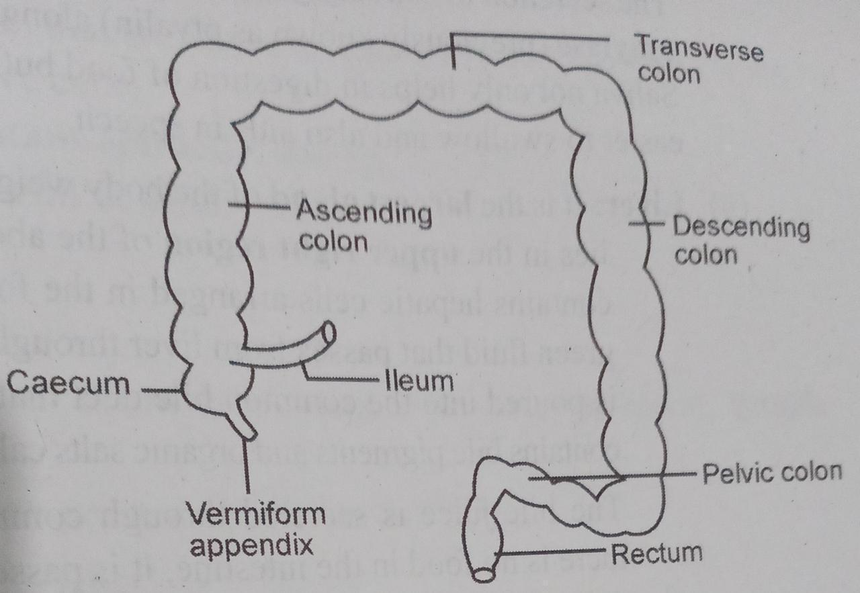
Parts of a large intestine
Layers of The Alimentary Canal:
- The wall of the alimentary canal has four layers called serosa, muscularis, sub-mucosa, and mucosa.
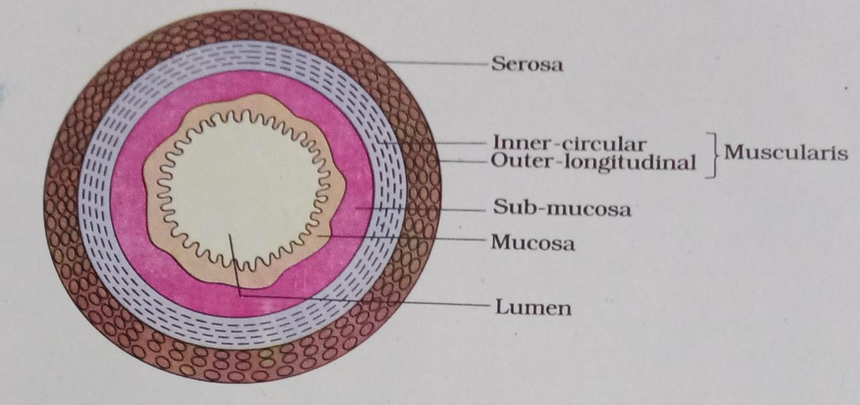
Diagrammatic representation of a transverse section of the gut.
Serosa is the outermost layer.
Muscularis is composed of smooth muscles.
Loose connective tissues containing nerves, blood, and lymph vessels compose the sub-mucosal layer.
The mucosa is the innermost layer of the alimentary canal. It forms irregular folds called rugae in a brush border appearance. These modifications increase the surface area enormously.
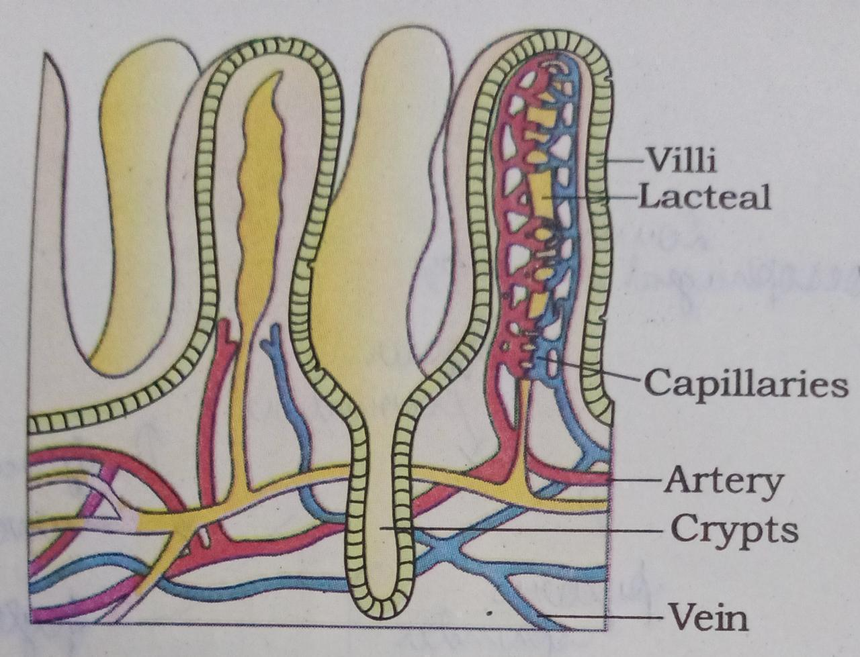
A section of the small intestinal mucosa
Digestive Glands:
There are 3 pairs of salivary glands:
The parotids (cheek)
The submaxillary/submandibular (lower jaw)
The sub- linguals (below the tongue).
They secrete salivary juice into the buccal cavity.
Liver:
- It is the largest gland of the body with a weight of about 1.2 to 1.5 kg in an adult human.
- The hepatic lobules are the structural and functional units of the liver and each lobule is covered by thin connective tissue called the Glisson’s capsule.
- The bile is stored in the gall bladder.
- The duct of the gall bladder called the cystic duct along with the hepatic duct forms the common bile duct.
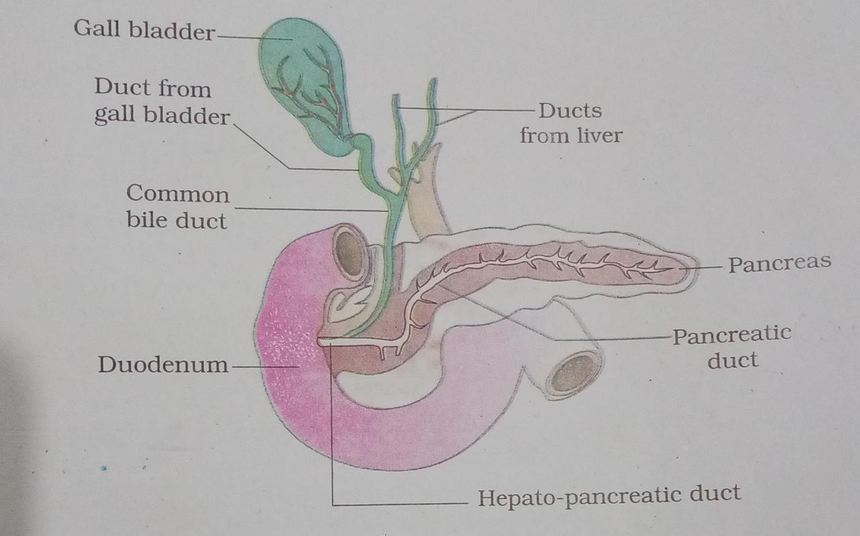
The duct systems of the liver, gallbladder, and pancreas
Digestion of Food
- The process of digestion is fulfilled by mechanical and chemical processes. The buccal cavity performs two major functions:
- Mastication of food
- Facilitation of swallowing.
- Mucus helps in the lubrication of the masticated food particles into a bolus. The bolus goes through the oesophagus by peristalsis (waves of muscular contractions). The saliva is composed of electrolytes like Na+, K+, Cl-, HCO3- and enzymes like salivary amylase and lysozyme.
- The chemical process of digestion is started in the buccal cavity by salivary amylase. About 30 percent of starch is hydrolysed by this enzyme (optimum pH 6.8) into maltose.
- Lysozyme acts as an antibacterial agent that prevents infections.

- The mucosa of the stomach has gastric glands. Gastric glands have 3 types of cells namely -
(i) Mucus neck cells -secrete mucus
(ii) Peptic or chief cells- secrete the proenzyme pepsinogen
(iii) Parietal or oxyntic cells - secrete HCl and intrinsic factor-factor essential for the absorption of vitamin B12.
- The stomach stores the food for 4-5 hours and the food mixes with gastric juice of the stomach. It is facilitated by the churning movements of its muscular wall and is called the chyme. The inactive enzyme pepsinogen reacts with HCl and gets converted into the active enzyme pepsin. Pepsin is responsible for the conversion of proteins into proteoses and peptides (peptones).
- The muscularis layer of the small intestine generates various types of movements which help in the mixing of the food with various secretions in the intestine.
- Pancreatic juice contains inactive enzymes – trypsinogen, chymotrypsinogen, procarboxypeptidase, amylases, lipases, and nucleases.
- The bile released into the duodenum through the hepato-pancreatic duct contains bile pigments (bilirubin and biliverdin), bile salts, but no enzymes. The function of bile is the emulsification of fats( breaking down the fats into very small micelles).
- Secretions of brush border cells and goblet cells constitute the intestinal juice/ succus entericus. They have a variety of enzymes like disaccharidases, dipeptidases, lipases, nucleosidases, etc. The mucus along with HCO3- protects the intestinal mucosa from acid and provides an alkaline medium (pH 7.8) for enzymatic activities.
Proteins, proteoses, and peptones are acted upon by the proteolytic enzymes of pancreatic juice.

Carbohydrates are hydrolyzed by pancreatic amylase into disaccharides.

Fats are broken down by lipases.

Nucleases act on nucleic acids.

The enzymes in the intestinal juice react with the end products to form absorbable forms.
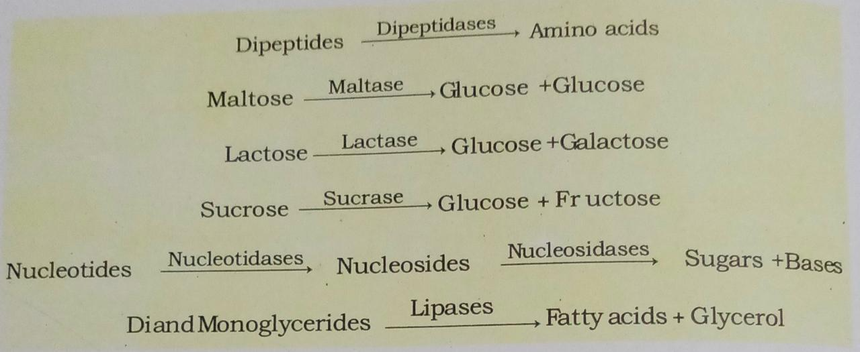
- Jejunum and ileum regions of the small intestine absorb the absorbable substances.
- In the large intestine, no digestive activity occurs and undigested substances are passed to the large intestine. The large intestine absorbs water, minerals, and certain drugs and helps in the secretion of mucus which helps in lubrication.
The undigested substances enter into the large intestine through the ileo-caecal valve and are stored in the rectum till defecation.
Absorption of Digested Products
Absorption is the process by which end products of digestion pass into the blood or lymph.
It is carried out by passive, active, or facilitated transport mechanisms.
Small amounts of monosaccharides are absorbed by simple diffusion.
Glucose and amino acids are absorbed with the help of carrier proteins, this mechanism is called facilitated transport.
Various nutrients like amino acids, monosaccharides like glucose, electrolytes like Na+are absorbed by active transport.
Fatty acids, glycerol cannot be absorbed into the blood and are incorporated into small droplets (micelles) which move into the intestinal mucosa. They are re-formed into small protein-coated fat globules(chylomicrons) which are transported into the lymph vessels called lacteals in the villi.

The Summary of Absorption in Different Parts of the Digestive System
- The absorbed substances utilise them for their activities by assimilation.
Disorders of Digestive System
Jaundice: In jaundice, the liver is affected. Also, skin and eyes turn yellow due to the deposition of bile pigments.
Vomiting is the ejection of stomach contents through the mouth. It is a reflex action controlled by the vomiting center in the medulla.
Diarrhoea: It is the abnormal movements of the bowel and increased liquidity of the faecal discharge.
Constipation: The bowel movements occur irregularly and faeces are retained in the large intestine.
Indigestion: It gives a feeling of fullness.
PEM: Protein-energy malnutrition (PEM) produces Marasmus and Kwashiorkor.
Marasmus: It occurs due to a deficiency of calories(carbohydrates).
Kwashiorkor happens due to protein deficiency. Symptoms of Kwashiorkor include a wasting of muscles, thinning of limbs, failure of growth, and brain development.
Chapter-Wise NCERT Class 11 Notes Biology
NCERT Class 11 Biology Chapter 16 Notes |
Significance of NCERT Class 11 Biology Chapter 16 Notes:
The NCERT notes of Digestion and Absorption Class 11 helps to revise the chapter and to get an idea about the main topics covered in the chapter. It covers the main topics of the Class 11 CBSE Biology Syllabus. It also helps the students to prepare for competitive exams like AIPMT, AIIMS, NEET, etc.
Subject Wise NCERT Exemplar Solutions
- NCERT Exemplar Class 11 Solutions
- NCERT Exemplar Class 11 Maths
- NCERT Exemplar Class 11 Physics
- NCERT Exemplar Class 11 Chemistry
- NCERT Exemplar Class 11 Biology
Subject Wise NCERT Solutions
Frequently Asked Questions (FAQs)
The food stays in the stomach for 4-5 hours during which it gets blended completely with the acidic gastric juice present in the stomach through churning movements of the muscular walls. This food is known as chyme.
The enzyme enterokinase activates trypsinogen to trypsin. The enzyme is secreted by the intestinal mucosa.
In the wall of the stomach.
Nucleotidases and nucleosidases.
Digestion is the process of conversion of complex food substances to simpler substances that can be absorbed by mechanical and biochemical methods.
The salivary glands, the liver and the pancreas, are the lists of glands, concerned with the alimentary canal.
Popular Questions
Courses After 12th
Applications for Admissions are open.
As per latest syllabus. Physics formulas, equations, & laws of class 11 & 12th chapters
JEE Main Important Chemistry formulas
Get nowAs per latest syllabus. Chemistry formulas, equations, & laws of class 11 & 12th chapters
JEE Main high scoring chapters and topics
Get nowAs per latest 2024 syllabus. Study 40% syllabus and score upto 100% marks in JEE
JEE Main Important Mathematics Formulas
Get nowAs per latest syllabus. Maths formulas, equations, & theorems of class 11 & 12th chapters
